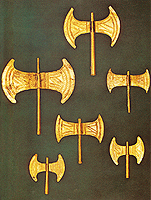 Among the main archaeologic finds of religious significance are the double axes
used as cult objects or votaries.
They were most likely a symbol of the sacrificial bull.
The cult axes were large and the
votive axes were small. Apart from the palaces and
settlements, such as Nirou Khani,
Agia Triada, Tylissos, Gournia, Palaikastro, Platanos and Knossos, votive axes
have also been found in sacred caves such as Arkalochori, Psychro and Skoteino.
Among the main archaeologic finds of religious significance are the double axes
used as cult objects or votaries.
They were most likely a symbol of the sacrificial bull.
The cult axes were large and the
votive axes were small. Apart from the palaces and
settlements, such as Nirou Khani,
Agia Triada, Tylissos, Gournia, Palaikastro, Platanos and Knossos, votive axes
have also been found in sacred caves such as Arkalochori, Psychro and Skoteino.
Double axes are often depicted on pots and seals, between sacred horns, on bulls' heads or suspended from helves. The devotional scene on the Agia Triada sarcophagus depicts double axes on leaf-covered helves, and there is a birdlike effigy of the deity perched on a pedestal on the top.